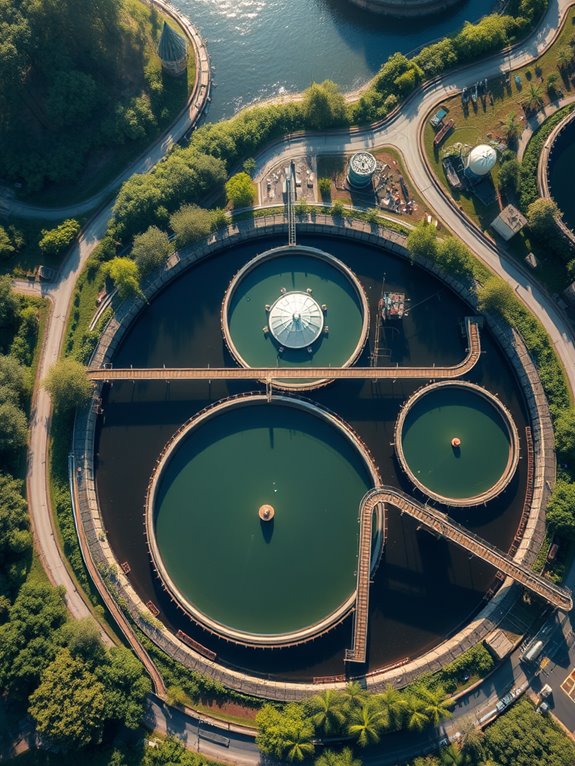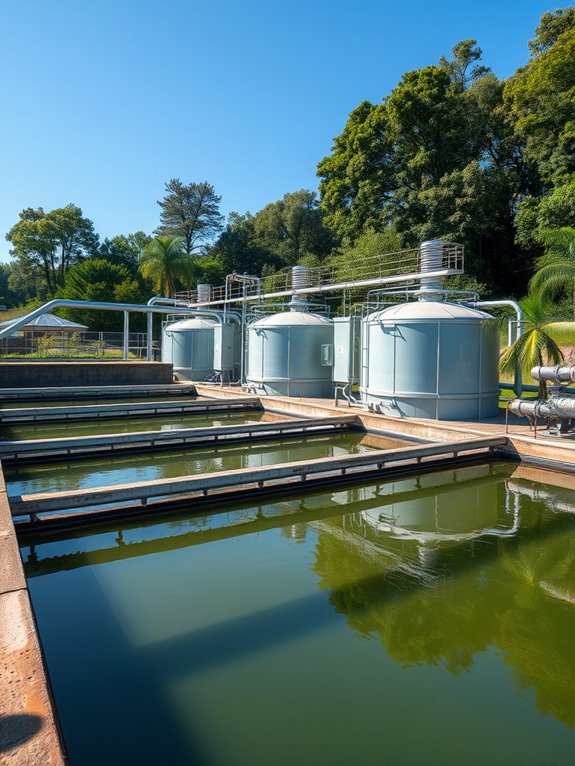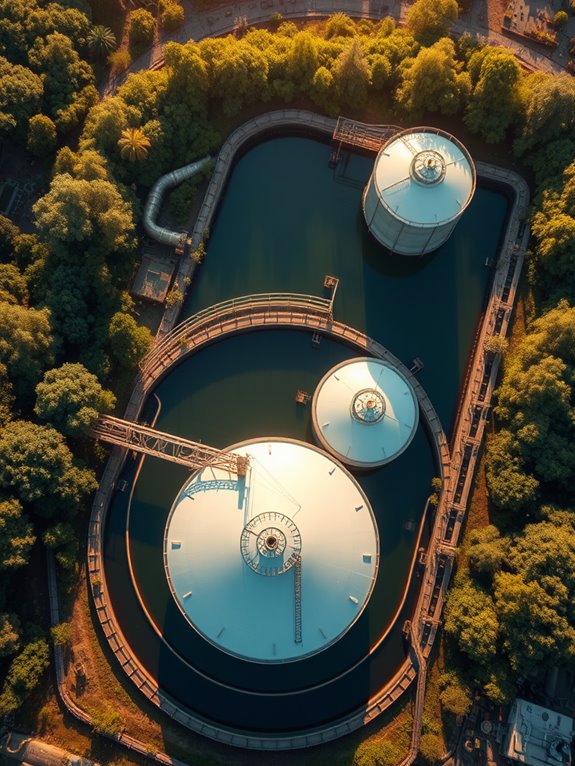Yes, water treatment plants are considered industrial facilities. They play a crucial role in ensuring clean and safe water for communities using advanced technology and various treatment processes. These facilities are governed by strict regulations to protect public health and maintain environmental standards. They also contribute economically by creating jobs and supporting local businesses. If you’re curious about how these plants operate and their broader impacts, there’s more to discover!
Definition of Industrial Facilities

Industrial facilities are essential structures designed for manufacturing, processing, and treating various materials, including water. These facilities encompass a wide range of operations, from factories producing goods to plants that refine materials.
You’ll often find them in sectors like construction, food production, and chemicals. Each facility is equipped with specialized equipment tailored for its specific processes.
Safety and efficiency are vital in these environments, as they typically operate under strict regulations. Understanding the definition of industrial facilities helps you appreciate their role in the economy and the significance of their contributions to everyday products and services.
Role of Water Treatment Plants
Water treatment plants play an essential role in ensuring clean and safe water for communities.
They not only handle the purification process but also address environmental impacts and comply with regulatory standards.
Understanding their functions helps you appreciate the importance of these facilities in our daily lives.
Water Purification Process
Although you might take it for granted, the water purification process is crucial for ensuring safe drinking water.
Water treatment plants employ various methods to filter out contaminants and pathogens. Here’s what happens during the process:
- Coagulation: Particles clump together for easier removal.
- Sedimentation: The heavy particles settle at the bottom.
- Filtration: Water passes through layers of sand and gravel to remove remaining impurities.
- Disinfection: Chlorine or UV light kills harmful microorganisms.
These steps work together to provide you with clean, safe water, highlighting the crucial role of water treatment plants in your daily life.
Environmental Impact Considerations
While you mightn’t always think about it, the role of water treatment plants extends beyond just providing clean drinking water; they also play an essential part in protecting the environment.
These facilities remove harmful contaminants from wastewater, preventing pollutants from entering rivers, lakes, and oceans. By treating water responsibly, you help preserve aquatic ecosystems and safeguard public health.
Additionally, water treatment plants often promote water recycling and conservation, reducing the demand on natural resources. This sustainable approach not only benefits the environment but also enhances community resilience against water scarcity, making your local ecosystem healthier and more robust for future generations.
Regulatory Compliance Standards
Regulatory compliance standards are essential for the effective operation of water treatment plants, ensuring they meet safety and environmental guidelines. By adhering to these standards, you help protect public health and the ecosystem.
Here are key aspects to reflect on:
- Permitting: You must obtain necessary permits before starting operations.
- Monitoring: Regular testing of water quality is required to meet safety standards.
- Reporting: Timely submission of compliance reports to regulatory agencies is vital.
- Training: Staff must be trained on compliance protocols and safety procedures.
Staying informed about these regulations keeps your plant running efficiently and responsibly.
Don’t miss out on related tips: Read this next: Are Water Treatment Plants Safe? A Deep Dive Into Water Safety
Industrial Processes in Water Treatment

When it comes to industrial processes in water treatment, you’ll encounter various treatment methods that guarantee water is safe for use.
You’ll also see how advanced equipment and technology play vital roles in these processes while adhering to regulatory compliance standards.
Understanding these elements helps you appreciate the complexities involved in providing clean water.
Treatment Methods Overview
Understanding the various treatment methods used in industrial water treatment is essential for ensuring clean and safe water.
These methods help in removing contaminants and making water suitable for industrial use.
Here’s a quick overview of some common treatment techniques:
- Filtration: Removes suspended solids and particles.
- Chemical Treatment: Uses chemicals to neutralize contaminants or aid in coagulation.
- Biological Treatment: Employs microorganisms to break down organic matter.
- Membrane Technology: Utilizes semi-permeable membranes to separate impurities.
Equipment and Technology
While various treatment methods are essential for ensuring water quality, the equipment and technology that support these processes play an equally important role. From filtration systems to chemical dosing units, each component directly impacts efficiency. Advanced monitoring tools help you track water quality in real-time, ensuring compliance with standards.
| Equipment Type | Purpose |
|---|---|
| Filtration Systems | Remove impurities |
| Chemical Dosing Units | Adjust chemical levels |
| UV Treatment | Disinfect pathogens |
| Pumps | Transport water |
Understanding these technologies can improve your water treatment operations considerably.
Regulatory Compliance Standards
Effective water treatment relies not just on advanced equipment and technology but also on adhering to regulatory compliance standards.
You need to understand these regulations to ascertain safe and efficient operations. Compliance helps protect public health and the environment.
Here are some key aspects to ponder:
- Federal and state regulations govern water quality.
- Regular testing and reporting are mandatory.
- Staff training is essential for compliance.
- Non-compliance can lead to hefty fines and operational shutdowns.
Staying informed about these standards not only safeguards your facility but also enhances community trust in your water treatment processes.
There’s more to explore! Here’s another valuable read: How to monitor water quality – Essential tips and tools
Regulatory Framework for Water Treatment Plants
Regulations governing water treatment plants play an essential role in ensuring safe and clean drinking water for communities.
You’ll find that these regulations stem from federal, state, and local laws, each setting specific standards for water quality and operational procedures. The Safe Drinking Water Act (SDWA) is a key federal law, establishing limits on contaminants and requiring regular monitoring.
States often have additional regulations to address local concerns. Compliance with these frameworks is vital for maintaining public health and safety, so your local water treatment facility must stay up-to-date with all regulatory requirements to effectively serve its community.
Here’s another post you might find useful: How Does a Water Treatment Plant Work? Step-by-Step Process
Environmental Impact of Water Treatment Facilities

Although water treatment facilities are essential for providing safe drinking water, they can also have significant environmental impacts. You should be aware of these effects to understand the broader implications of water treatment processes.
Some key concerns include:
- Chemical runoff: The use of chemicals can lead to contamination of local waterways.
- Energy consumption: High energy use contributes to greenhouse gas emissions.
- Sludge disposal: Residual sludge can impact soil and water quality if not managed properly.
- Habitat disruption: Construction and operation can affect local ecosystems and wildlife.
Being informed helps you advocate for more sustainable practices in your community.
Economic Contributions of Water Treatment Plants
Water treatment plants not only play an essential role in ensuring safe drinking water but also contribute considerably to the economy. They create jobs, from engineers and technicians to administrative staff, boosting local employment rates.
The facilities often require regular maintenance and upgrades, stimulating demand for construction and manufacturing services. Additionally, by providing clean water, they support local businesses, promoting tourism and attracting new residents.
Water treatment plants also help prevent costly health issues related to contaminated water, saving communities money in healthcare expenses. Overall, these plants are crucial economic engines that enhance quality of life and community development.
Comparison With Other Industrial Operations

When comparing water treatment plants to other industrial operations, it’s clear that their purpose and impact extend beyond mere production.
While many industries focus on profit and material goods, water treatment plants prioritize public health and environmental sustainability. They’re crucial for maintaining clean water supplies and ensuring safe drinking water for communities.
- Water treatment plants protect public health.
- They contribute to environmental sustainability.
- They utilize advanced technologies for efficient operations.
- They create jobs and stimulate local economies.
In this way, water treatment plants stand out as essential components of our industrial landscape, serving both people and the planet.
Conclusion
To sum up, water treatment plants are indeed considered industrial facilities due to their complex processes and significant impacts on the environment and economy. For instance, imagine a small town investing in a state-of-the-art water treatment plant that not only cleans its water supply but also creates jobs and boosts local businesses. By understanding the multifaceted role of these plants, you can appreciate how essential they are to both public health and industrial operations.

I’m Allen Kim, the chief editor of plumbinginto. I am a mid level plumber and assign to an local firm over 4 years of experience. During the working period, most of my experience is related to the house plumbing. I learned about the thing, when working with most experienced people in this sector, one must be as good as the inspector or better with knowledge of the project as well as the practical aspects of plumbing industry.